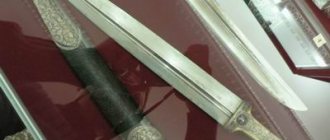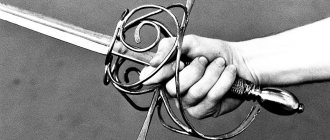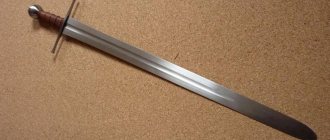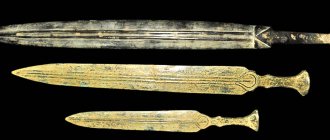Fans of the Warhammer 40,000 universe are probably familiar with the effective melee weapon of the Space Marines, like the chainsword (a one-handed analogue of a chainsaw). The weapon is credited with fantastic characteristics, such as cutting weak enemies in half, as well as being highly effective against tank armor. But is this possible in real life? Why is nothing like this used in modern troops? Let's look at these questions in this article.
Chain wear resistance problem.
The weakest point of any chainsaw is the cutting chain. It regularly has to be sharpened and maintained, or even replaced as it stretches. On average, the work of one chain on wood before the first straightening is 3-4 hours. Now imagine, in front of you is an enemy in protective equipment, which contains metal and composite materials, how long will such a weapon last for you?
Chain rotation speed.
How much time will you spend cutting a tree with a diameter of 20 cm? Everything will depend on how fast the chain on your saw rotates, the quality of the chain, and the type of wood. On average it is from 10 to 3 seconds. An enemy dressed in protective armor will not wait for you to saw him. In order to cause instant damage during an impact, the chain must rotate at fantastic speeds, on the order of 30,000 revolutions, if not more.
Energy consumption.
Weight.
Given its dimensions, such weapons become very bulky and heavy. Not every person will be able to swing and strike with such a weapon and parry the blows. You will need a lot of stamina to actively move around the battlefield, hide from the eyes of enemies, and make unexpected attacks.
High risk of jamming.
As you know, chain saws are quite effective in cutting wood. Have you ever tried sawing fabric or tarpaulin? Your saw will simply jam due to the rags getting tangled up. The same story can happen if the blade of a chainsword touches the enemy’s clothing. While you are freeing your chainsword from its rags, you will become unarmed and helpless.
Unmasking noise.
A man who swings a chainsword with a noise level of 70 decibels will certainly become a priority target for enemy fire. You simply won't reach the enemy. Even if you sneak up on the target, eliminating it will cause a lot of noise. In this case, an ordinary knife will be much cheaper and more effective.
Ineffectiveness of open hand-to-hand combat.
Since the first machine guns appeared, the practice of using open hand-to-hand combat began to fade away. Modern machine guns have a sufficient rate of fire and range to eliminate any melee attack. Hand-to-hand combat is mainly used in close quarters by special services, since the use of firearms in these conditions is dangerous due to the ricochet of bullets for the attacker. There is also a technique for covertly eliminating targets.
The Legend of Zelda: Breath of the Wild – Most weapons
Almost every weapon in The Legend of Zelda: Breath of the Wild will be useless in our world, and all because they break after a certain number of uses. Some have increased durability, but they still wear out much faster than a regular sword or bow. Even the Master Sword needs to be constantly recharged (unless you have the Master Trials DLC)! No matter how powerful the weapons here are, time will pass and there will be nothing left of them.
Deus Ex - PS20
By Deus Ex standards, the PS20 is nothing special: just a disposable plasma pistol. However, it has a good blast radius and a fairly impressive explosion. However, both in the game and in life, one charge does not inspire optimism. Why not choose instead... any other weapon that won't become useless after the first and last shot?
Monster Hunter – Hammers
Of all the large and impractical weapons on this list, hammers in Monster Hunter at least present themselves deliberately: they are designed to be heavy and slow even in the game, completely dependent on the driving force of a particular attack. However, this means that in real life it would be even more difficult to handle them, and the only advantage would be their size, which would outstrip even a sledgehammer.
Metal Gear Solid 5: The Phantom Pain – Bionic Arm
Let's be realistic: modern prosthetic technologies in our world are not so developed. And this is if we talk about motor function, keeping silent about electric shock, explosions and teleportation. And while the bionic arm from Metal Gear Solid 5: The Phantom Pain is heavy enough to take down someone, in reality it would be no more effective than a regular baton.
It can knock out an enemy from behind, but for this purpose there are weapons that are much more compact and convenient. Even if by some miracle it were possible to bring a bionic arm into reality with all its functions, it would be incredibly difficult to handle, especially compared to more affordable alternatives.
Brass knuckles “deer horns”
Brass knuckles-knives in the form of two crossed crescents “Deer Horns” were a formidable dual Chinese weapon used by the creator of the Ba Guazhang school of kung fu, Dong Hai Chuan. There were legends that a certain tax collector of that time relied only on his knives while traveling, single-handedly dealing with gangs of robbers. The technique of using this brass knuckle knife was based on the Ba Guazhang system of unarmed combat, and students were allowed to use exotic weapons only after many years of bare-handed training due to the high likelihood of injury.
Double Dragon Neon – Comb
In Double Dragon Neon, you can use a hairbrush to nail your opponent with one well-aimed throw. However, unless you're skilled in John Wick-style pencil martial arts, a hairbrush probably won't be your best weapon in the real world. Even in the game, it's not particularly useful, other than allowing you to unlock a fun achievement when throwing at Skullmageddon.
Tekko
Tekko is an Okinawan weapon known as the "iron fist" in some provinces. It was traditionally made of wood and metal, and the blade was shaped like a crescent. There were three small spikes on the rim of the tekko, with which they tried to hit the joints, ribs and collarbones. If the enemy tried to grab the forearms of the owner of such brass knuckles, then a simple turn of the wrist was enough to cut his hands.
GoldenEye 007 – “Klobb”
What's wrong with this weapon? First of all, guns are made to kill, right? But Klobb somehow became an exception to this rule. Its damage is simply sad, since one shot is not enough regardless of the mode. There is no need to talk about accuracy. The rate of fire is even worse. Still better than nothing? Perhaps, but even a stone, if thrown successfully, will become a more formidable weapon than the Klobb.
Blood Reaper
According to statistics, 24% of players use this particular weapon and voted for it as the best. But getting it is not so easy. It is worth a huge amount of rubies. You can get rubies in several ways:
- Accumulate rubies by completing daily tasks;
- You can watch advertisements, for which you also get rubies;
- If you are completely unbearable and want the Bloody Reaper here and now, your option is donation.
But despite its inaccessibility, it has amazing mechanics and decent damage. We advise you to try and save up rubies for it.
Monster Hunter – Hammers
Of all the large and impractical weapons on this list, hammers in Monster Hunter at least present themselves deliberately: they are designed to be heavy and slow even in the game, completely dependent on the driving force of a particular attack. However, this means that in real life it would be even more difficult to handle them, and the only advantage would be their size, which would outstrip even a sledgehammer.
DOOM – BFG-9000
If you want to mow down legions of enemies, the BFG-9000 is a great choice. However, only the main character of Doom can handle this unit without much effort, but an ordinary person would be completely destroyed by the recoil. And this does not take into account the plasma spray, which could very well kill us in a matter of seconds. And this gun - what a surprise! – huge and bulky, which would make it difficult to aim during a real battle.
Santensu
The santensu as a weapon was a pocket-sized iron rod that was usually equipped with a ring attached to the center. The middle finger was inserted into the ring, and the rod was squeezed in the palm. Perhaps because of its simplicity, the santensu was easily adapted to a specific warrior. The ring could be equipped with long spikes to add additional damaging power to the blow. Santensa was used more for killing than for self-defense.
Bloodborne – Wheel of Logarius
Surely being hit by a huge wooden wheel would be painful in real life. But alas, the Logarius Wheel has other problems. Despite the fact that in terms of characteristics this is a powerful and almost universal weapon, its enhancement comes at the expense of health. In reality, the Wheel would simply kill you. In addition, this is another case of excessive bulkiness.
Top 10 Mysterious Swords from Legends and History
The swords of famous people are the source of legends. Fueled by tales of bloodshed and conquest, throughout history there have been swords whose fame has risen to mythical proportions due to the tendency of people to mix fact and fiction to such an extent that they are inseparable from each other. Some of these swords may actually be legends come to life, but the stories of others are so strange that you can't help but question their veracity. There is no other type of weapon in the world that would leave such an impressive mark on human history. 10. Sword In The Stone
Although the legend of King Arthur is largely folklore and myth, there is evidence that the story of the sword in the stone may be true.
In the Chapel of Monte Siepi, Italy, there is an ancient sword stuck into a stone that is likely the key to finding the source of the legend. It is believed that Saint Galgano Guidotti was a Tuscan knight who was ordered by Archangel Michael to give up sinful habits. Galgano said that it would be as difficult as splitting a rock, and tried to prove his point by breaking the sword on a nearby rock. According to legend, the blade of the sword pierced the stone like a hot knife into butter. The sword is still in the stone, where Galgano left it, who then abandoned his sinful life. After Saint Galgano was canonized, the story of his holy sword quickly spread among the people. The Excalibur legend predates Galgano, but the direct mention of the sword in the stone was added to the legend shortly after Galgano. According to the theory, the saint's sword served as a real prototype of Arthur's sword in stone. Of course, it all depends on whether the sword actually belonged to Galgano. Many believe that the origin of the sword may not be related to the saint at all. However, Luigi Garlaschelli from the University of Pavia recently carbon dated the sword, which showed that the sword was made in the 12th century, which coincides with the life of Saint Galgano, although this is certainly not the case. proof of the veracity of the immediate story. 9. Kusanagi no Tsurugi
According to legend, Kusanagi (“Grass Cutting Sword”) was found in the body of an eight-headed dragon killed by the god of thunderstorms and seas.
It is part of the regalia of the Japanese emperors, a symbol that the ancient Japanese dynasty of emperors descended from the Sun Goddess - proof of their god-given right to rule. The Kusanagi is believed to be kept at the Atsuta shrine in Nagano Prefecture, although it is not shown to the general public and has not been seen for centuries. The sword is sometimes brought to the coronation ceremony of emperors, but it is always wrapped in cloth. Although no one has ever seen it, and the sword is mentioned only in pseudo-historical documents and oral history, Japanese authorities continue to make the whole world wonder whether Kusanagi actually exists - neither refuting nor confirming its existence. The only official mention of the sword dates back to the end of World War II - although the emperor renounced his divine nature and origin, he still ordered the guardians of the regalia of the Japanese emperors to “protect the regalia in any way possible.” 8. Durandal
For hundreds of years, a mystical sword has been stuck in the mountain above the Notre Dame chapel in Rocamadour, France. The monks say that this is Durandal, the sword of the paladin Roland. According to legend, Roland plunged the holy sword into the mountain so that his enemies would not take possession of it. Since the 12th century, the chapel has been a place of pilgrimage. In 2011, the sword was removed from the mountain by municipal authorities and transferred to the State Museum of the Middle Ages - Baths and Mansion of Cluny (Cluny Museum), in Paris, for exhibition. But is this sword actually Durandal? Although the battle in which Roland died is a well-documented event, the first mention of Durandal can be found in The Song of Roland, composed hundreds of years later - around the same period when monks began to claim that the sword belonged to Roland. They most likely linked their sword to Durandal for the reason that Rocamadour was the beginning of his journey, although his last battle took place hundreds of kilometers away, in the valley of Roncesvaux. So, unfortunately, this is unlikely to be Roland's sword, no matter how much the monks would like it, excluding the possibility that Roland was able to throw the sword a couple of hundred kilometers. And yet, the true origin of the sword remains a complete mystery. 7. Cursed Muramasa
Muramasa was an ancient Japanese swordsman who, according to legend, prayed that his swords would be "great destroyers."
Due to the incredible quality of his swords, the gods decided to fulfill his wish and infused the swords with a bloodthirsty spirit, which, if not fed by battle, drove the owner to suicide or murder. There are countless stories of Muramasa sword owners going mad or being killed. Swords were considered cursed and were banned by imperial decree. The decree was passed by Shogun Tokugawa Ieyasu, who banned swords after nearly his entire family died from them. His grandfather was killed by the Muramasa sword, and Ieyasu himself and his father were wounded by the same swords. In the end, his wife and adopted son were executed with supposedly cursed swords. But were Muramasa swords actually cursed? Most likely, Ieyasu's problem with swords arose simply because they were incredibly popular. Muramasa is actually not one person, but a whole school of swordsmen, which was opened directly by Muramasa. High-quality Muramasa swords were made for almost a century and Japanese warriors often used them. The fact that Muramasa swords were used in so many murders associated with the shogun is, of course, a coincidence. 6. Honjo Masamune
The opposite of the cursed swords of Muramasa are the swords of the legendary priest and swordsman Masamune.
Legend has it that Masamune and Muramasa tested who was the best swordsman by dipping their blades into a river. While Muramasa's sword cut everything it touched, Masamune's sword did not cut anything that was unworthy of it - not even air. Although Masamune's work is considered a Japanese national treasure, one of the swords has never been found. After Japan's surrender in World War II, the Honjo Masamune was given to an American soldier, Sgt Coldy Bimore, who most likely took it home as a souvenir. The mysterious American soldier was never found, nor was the sword itself. Despite the sword's undeniable value (it is valued at several million dollars), sword collectors are no closer to finding the legendary lost sword Masamune. 5. Joyeuse
Joyeuse, the legendary sword of Charlemagne (King Charlemagne), according to legend, changed its color 30 times a day and was so bright that it eclipsed the Sun.
Since at least 1271, two swords called Joyeuse have been part of the coronation ceremony in France. But since the two swords cannot be the famous Joyeuse, the mystery of which one is actually the sword of the “Holy Roman Emperor” remains unsolved. Joyeuse, located in the Louvre, has undergone great changes over its long history. The oldest part of it is the handle, the origin of which has been dated by recent studies to between the 10th and 11th centuries. Charlemagne died in 813, so the sword does not coincide a bit with the life of the Holy Roman Emperor. Another contender for the title is the "Sabre of Charlemagne", located in the Vienna Treasury (Imperial Treasury) in Austria. It is unknown how it became part of the French Imperial Regalia, but the saber dates from the early 10th century - closer than Joyeuse, but still cannot be the legendary sword of Charles. The saber was most likely created by swordsmen from Hungary, which added unnecessary legends that this is the famous “sword of Attila”, which Mars, the god of war, allegedly gave to Attila, the leader of the Huns (Attila the Hun). Unfortunately, this is also not historically plausible. 4. St. Peter's Sword
There are several legends about the sword used by Saint Peter to cut off the ear of the assistant high priest in the garden of Gethsemane.
According to English mythology, the sword, along with the Holy Grail, was brought to England by Joseph of Arimathea. However, in 968, Bishop Jordan brought the sword to Poland - and this particular sword, according to him, was the real sword of St. Peter. The Bishop's Sword, considered a real relic, remained in Poland and was then transported to the Archdiocese Museum in Poznan. Did the mysterious sword belong to Saint Peter? Some claim that the sword was made on the eastern frontier of the Roman Empire in the first century, but there is no evidence for this, other than the (possibly incorrect) belief of those who want to believe that the sword is a real relic. The sword in Poland is a falchion, a type of sword that was not used in the time of St. Peter. Metal studies also showed that the sword was made after the death of the saint. 3. Wallace Sword
According to legend, William Wallace - the main character in the film Braveheart - used human skin to make a scabbard, hilt and sword belt.
The "donor" of the flesh was Hugh de Cressingham, Treasurer of Scotland, whom Wallace flayed after winning the Battle of Stirling Bridge. According to one legend, Wallace used one strip of Cressingham leather for a sword belt. According to other legends, Wallace and his associates used Cressingham leather for the saddle girth. The legend spread even further when King James IV ordered the scabbard, hilt and belt to be replaced with something more suitable for such a great sword. The sword now in the National Wallace Monument is already a modified version of the original sword. Did Wallace once possess a Frankenstein sword? Although Cressingham was indeed flayed, it is more likely that Wallace used the tax collector's skin for a sword belt rather than for sword parts. The story also took place in England, which means it was most likely intended to make the Scottish hero look like a barbarian. Still, we understand Wallace's dislike of tax collectors. However, it is quite possible that he used the skin of one of them to decorate his sword. As with many other legends, the truth was lost in the past. 2. Sword Of Goujian
In 1965, an extraordinary sword was found in a damp crypt in China - despite being over 2,000 years old, there was not the slightest drop of rust on it.
The blade was so untouched by time that when one of the archaeologists tested its sharpness with his finger, blood was shed. Besides its unearthly durability, the sword's engraving was so elaborate that archaeologists did not believe such detail could have been achieved in those days. At that time, the sword was a real mystery. Further examination of the engraving revealed that it was a Goujian sword belonging to the Yue king, and is believed to be a legendary sword mentioned in The Lost History of Yue. According to legend, when King Goujian assessed his collection of swords, this was the only sword worthy. The sword was so magnificent that it was believed that it was made by the joint efforts of Heaven and Earth. How did the sword manage to remain in such excellent condition for over 2,000 years? Research shows that Yue swordsmen achieved such a high level of metallurgy that they were able to add anti-corrosion alloys to their blades. Their swords were also treated with anti-corrosion substances, which helped them remain in excellent condition for such a long time. Additionally, as luck would have it, the sword's scabbard was nearly airtight, preventing oxidation and allowing the legendary sword to remain in such pristine condition - even after spending two millennia in a tomb. 1. Seven-Branched Sword
In 1945, a mysterious sword was found in the Isonokami shrine, Japan.
The sword was very unusual - six branches protruded from its sides (the end of the blade is considered the seventh branch). The sword was in poor condition, but the faint writing on the blade was still legible. The exact translation has been disputed several times, but it is certain that the sword was a gift from the King of Korea to the Japanese monarch. This description matched the sword described in the Nihon Shoki, a document describing the early history of Japan. If this was the same seven-bladed sword that was given to the semi-mythical shaman empress Jingu, it would be an important sign that the legend had become fact. The date of manufacture of the sword coincided with reliable sources in China, Korea and Japan. The Isonokami-jingu was also mentioned in other documents dating back to the Nihon Shoki, so the sword may have remained in the shrine since ancient times. Scholars believe that the sword with seven branches is the same sword from the legend, so that the shaman empress Jingu received her place in official history. + Tizona (La Tizona)
The Tizona is the sword of the legendary El Cid, who fought for both the Christian army and the Muslims in Spain.
A museum in Burgos, Spain, displays a sword that the museum claims is El Cid's own. The sword was allegedly given to the Marquis of Falces by King Ferdinand in 1516. It was then passed down from generation to generation by members of the Fals family, but finally it was given to the Madrid Military Museum in 1944. There it remained for sixty years, and no one doubted its origin, but then the Marquis sold it Autonomous Region of Castile and Leon, for exhibition at the Burgos Museum. After the sale of the sword, the Ministry of Culture associated with the Military Museum began to spread information that the sword was in fact made several centuries after El Cid's death. Castile and Leon responded by conducting another study that confirmed the origin of the sword, and said that the ministry was simply jealous that it had lost the sword. In the epic poem Lay of El Cid, it is said that Tizona frightened her enemies so much that they fainted at the mere sight of the sword. The Sword in Burgos may not have made anyone swoon, but at the very least it has cleverly stirred up a lot of controversy. The origin of the sword remains a hotly debated topic. + Ulfberht
Although now forgotten, the Vikings in the past possessed a special type of sword that was far superior to any other European weapon. Ulfberht swords were thousands of years ahead of their time and were wielded exclusively by the elite Viking warriors. What made the Ulfberchts so good? While Viking swords were primarily made of low-carbon steel mixed with slag, the metal of these swords was comparable in strength to modern steel. They bore the inscription “+ULFBERH+T” and swords of comparable quality appeared in Europe only during the Industrial Revolution. How the Vikings were able to create these swords while the rest of Europe could only boast steel that broke like glass is a mystery. Scientists currently believe that the secret of the Ulfberchts lay in crucible steel, which the Vikings brought from Iran and Afghanistan. There is no exact information about who Ulfbercht was - or whether he was one person - but he was the only European blacksmith who worked with crucible steel at that time. And this made his swords a weapon that was head and shoulders above everything else.
The Legend of Zelda: Breath of the Wild – Most weapons
Almost every weapon in The Legend of Zelda: Breath of the Wild will be useless in our world, and all because they break after a certain number of uses. Some have increased durability, but they still wear out much faster than a regular sword or bow. Even the Master Sword needs to be constantly recharged (unless you have the Master Trials DLC)! No matter how powerful the weapons here are, time will pass and there will be nothing left of them.
Pata
Pata is a weapon invented in India. It was originally used by the ancient Maratha warrior caste and later spread throughout most of India. It was a sword attached to a gauntlet that protected the arm up to the elbow. Since the entire structure from the tip of the sword to the elbow was solid, the warriors were unable to move their wrist, so all movement came from the elbow. It is believed that such weapons were most often used by horsemen.
Silent Hill 2 – Pyramid Head's Great Knife
This knife is so huge that even Pyramid Head prefers to drag it along the ground. Of course, this was done more for the sake of intimidation, but even though Pyramid Head is able to handle the Knife like a sword, he is still a powerful monster. Few people will be able to lift such a colossus, not to mention use it effectively. The same Buster sword of Cloud, no less.
Knife-brass knuckles
A brass knuckle knife is a type of knife that is hidden hidden in a sleeve or on a belt. This is a stylized modern form of the ancient katar, where the blade is attached perpendicular to the handle and passed between the fingers. These knives became popular during the Gold Rush of the 19th century and became widespread among the criminal world.
Subscribe to the Military Observer channel in Yandex.Zen
News Media2
Dark Souls 3 – Swords of Knights from the City Beyond the Wall
When you first encounter these knights brandishing their swords, you are sure to be amazed. First of all, how dare the game unleash them on you before the next boss? Secondly, how gorgeous are these swords and the possible combos with them! Unfortunately, they again fall into the "too big to be useful" category. This case is even more severe due to the pairing of blades, although it is debatable that it will be possible to cope with one, or two hands.
Bastard sword: Kalashnikov from the Middle Ages
Yes exactly. Sword is a bastard. A logical question has already arisen in your mind: why is he a bastard? Maybe these swords were given only to bastards? Or were they forged by blacksmiths born out of wedlock? Not certainly in that way. It's all about the size of the sword. It was one-and-a-half-handed - not too long to be two-handed, but long enough to stop being one-handed. A kind of sword is neither here nor there: that’s why it was called a bastard, that is, not belonging to any of the classes.
The bastard originated at the beginning of the 15th century from a long knight's sword, although the first one-and-a-half swords were still in the 13th century. When fencing on foot and without a shield, knights often grabbed the sword by the pommel, increasing the maneuverability of the blade. Therefore, customer-oriented swordsmiths lengthened the hilt of the sword, while simultaneously making the pommel larger to make it easier to grip. At the same time, the origin of one-and-a-half-handed ones was not clear and linear: they were also made as variations of elongated one-handed ones.
you could often find such swords in various works; you could often find such swords in various works
The next question is: why is it needed like this? The main advantage of the bastard: it is extremely versatile. With it you can use both one-handed and two-handed sword techniques. It was much lighter than a long knight's sword, which made it possible to use it in everyday life for protection. At the same time, its sufficient length allowed it to fencing from a horse. In a word, the area of application of the bastard was enormous, which is why it gained such popularity in medieval Europe.
competition for the best comment. Leave your options below for the competition for the best comment. Leave your options below
Let's go over the dimensions. The length of the sword was approximately 100 - 130 centimeters, of which at least 20 centimeters was the handle. Weight - about one and a half kilograms. They were made of high-quality steel, not inferior to either the Japanese or the Arabs. By the way, the technology for manufacturing blade steel was known in Europe back in the 3rd century BC, that is, long before the Japanese with their katanas.
How did they fencing? As I already said, the main point of this sword is to use both one-handed and two-handed techniques. In the first case, it was successfully used in a shield + sword combination, which provided the warrior with good protection with the possibility of a counterattack. But if there was no shield at hand, or the warrior was simply tired, he could easily throw away the shield and take the bastard with both hands, without losing any attacking potential. The one-and-a-half-handed one was not much shorter than the two-handed one, but at the same time, it was significantly lighter, and therefore faster. Speaking about its versatility, we can separately note the fact that all parts of the sword were used in battle: with a blow from the cross or a massive pommel, one could easily break something to the enemy, for example, a skull.
note the massive pommel. If you get hit in the head with this, you won’t get away with a lump; pay attention to the massive top. If you get hit in the head like that, you won't get away with a bump
Do you think a medieval sword should be sharp? And how much? Spoiler: no, it shouldn't. Or rather, it should, but not much. The sharper the blade, the thinner the steel of the sword in this place, which means the sword becomes less durable. If you try to sharpen a sword to a razor sharpness, it will crumble in the first battle, hitting plate armor or another sword. The main essence of a sword is not its sharpness, but the force of the blow applied by the swordsman. Therefore, they were sharpened without fanaticism and not completely: the lower half of the sword, close to the hilt, was often unsharpened. This allowed the knight to grab the sword with one hand by the hilt and the other by the blade, which greatly improved control of the sword.
this technique was called the "Half Sword Technique". Holding the sword by the blade with his other hand, the knight handled it much faster and more efficiently; this technique was called the “half-sword technique.” Holding the sword by the blade with his second hand, the knight handled it much faster and more efficiently
Bastards were a kind of analogue of the Kalashnikov of that time. The most effective and most versatile, they were used both in the army and in civilian life. Even now they are quite popular in culture: most of the warriors in “Game of Thrones” are armed with them, Geralt from “The Witcher” carries one of them, they can often be seen in the game “Dark souls” - these are just a few examples.
An example of what a bastard is capable of
One and a half duel. Please note that the fighters periodically strike with one hand.
What can we learn from the bastard? Don't pay attention to what others think about you. Yes, you may be an outcast, you may not be like everyone else, but perhaps this is where your uniqueness and your path to greatness lies. One day, you may become popular throughout the world, and you will be praised for centuries. But essentially, you're still a stinking bastard.
Fallout 4 - "Fat Man"
Here's what will happen if you use the Fat Man in real life: 1) the weapon will shatter into small pieces because it was made too cheaply; 2) a nuclear charge will fall at your feet and kill you on the spot; 3) you will die either from an explosion or from radiation - depending on your luck.
Dark Souls 3 – Swords of Knights from the City Beyond the Wall
Kingdom Hearts – Key Sword
Firstly, there is no point in even dreaming of a key-sword if he himself did not choose you. Also, despite the rather useful ability to open any door (as well as strike down hundreds of Heartless), it attracts darkness to the owner. With him you are always in danger. Finally, this giant wrench is a nice percussion instrument, but there are too many better alternatives.
Final Fantasy 7 – Cloud's Buster Sword
Huge swords are, of course, cool, but the real chances of picking up something like that and, even better, swinging it like a regular sword are very small. It’s not that there haven’t been giant swords in history (the same mazhangao), but even in comparison with them, the Buster sword seems ridiculous and completely impractical.
GoldenEye 007 – “Klobb”
What's wrong with this weapon? First of all, guns are made to kill, right? But Klobb somehow became an exception to this rule. Its damage is simply sad, since one shot is not enough regardless of the mode. There is no need to talk about accuracy. The rate of fire is even worse. Still better than nothing? Perhaps, but even a stone, if thrown successfully, will become a more formidable weapon than the Klobb.
Deus Ex - PS20
By Deus Ex standards, the PS20 is nothing special: just a disposable plasma pistol. However, it has a good blast radius and a fairly impressive explosion. However, both in the game and in life, one charge does not inspire optimism. Why not choose instead... any other weapon that won't become useless after the first and last shot?
Madu
Ancient Muslim and Hindu beggars were not allowed to carry weapons, so they were forced to invent to protect themselves. They created mada, which was not considered a weapon. Initially it was made from the horns of an Indian antelope, later from metal, adding protective shields. As they say, the madou was used exclusively for self-defense. Even now you can find schools that fight with madou.
Gears of War – Hammer of Dawn
In theory, the Hammer of Dawn could be useful in reality. Unleash a giant space laser on your enemies? Priceless. However, there are also disadvantages, for example, changing the position of the satellite and, of course, a similar attack directed against you. Also, the Hammer of Dawn needs a lot of time to recharge and aim, not to mention its uselessness indoors.
Plate Sword
In second place in popularity is the Plate Sword. This sword has a huge number of advantages and is practically in no way inferior to the kusarigama. This Plate Sword costs 500 crystals and has an incredible attack range. Nim's attack covers almost half of the location, as it splits on the plate upon impact, so it can also be used as a fly. In addition, this sword has incredible coupling of blows, which allows you to strike almost without stopping, despite the speed of attacks of the Plate Sword being at an average level.











